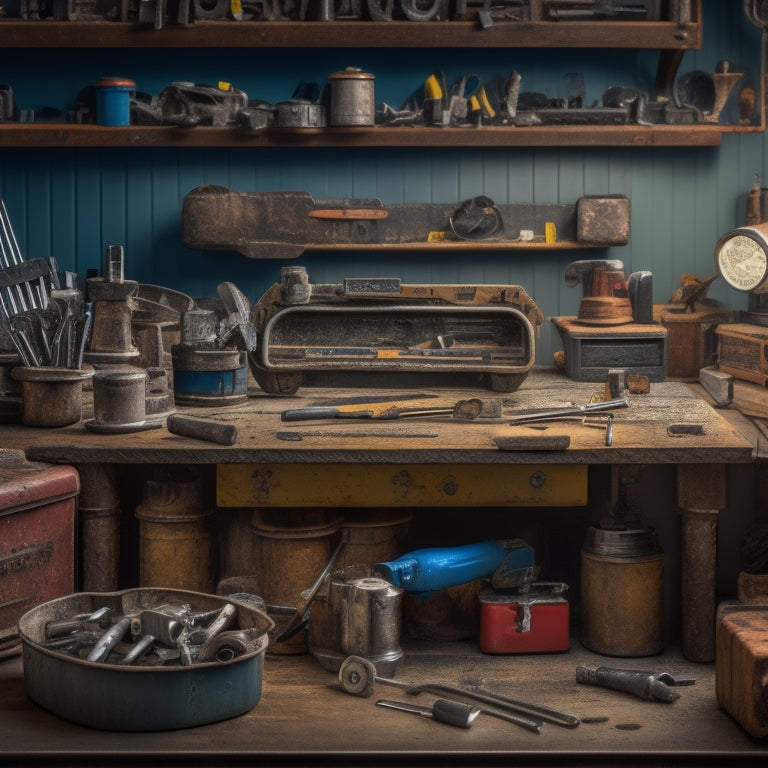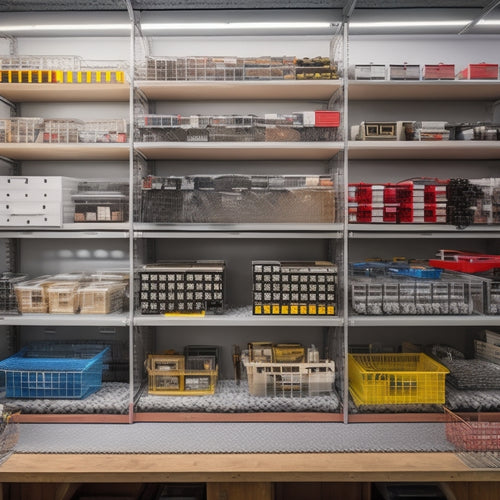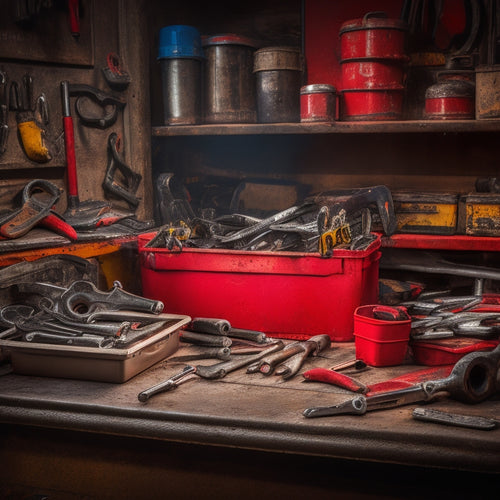
Top 10 Must Have Add Ons for the Tool Box
Share
To take your toolbox to the next level, you'll need these must-have add-ons. Start with an extensive socket set, including shallow and deep sockets in various drive sizes, and precision measuring tools like micrometers, Vernier calipers, and dial indicators. Add cordless power chargers, LED work lights, and toolbox organizers to guarantee efficiency and safety. High-torque wrenches, multipurpose pocket knives, drill bit storage cases, and heavy-duty toolbox wheels will also enhance your toolkit. By adding these essentials, you'll be equipped to tackle any project. Now, uncover how each of these add-ons can revolutionize your workflow and take your projects to new heights.
Key Takeaways
- A socket set with various types and drive sizes is essential for project efficiency and safety, reducing accident risks.
- Precision measuring tools like micrometers, vernier calipers, and dial indicators ensure accurate readings and quality control.
- Cordless power chargers are a must-have for keeping tools operational, with compatibility and maintenance being crucial for battery lifespan.
- LED work lights and hands-free illumination options provide improved visibility, reduce eye strain, and enhance task efficiency in poorly lit areas.
- Toolbox organization systems and pneumatic air accessories like air hose fittings, regulators, and tool maintenance enhance efficiency, safety, and overall performance.
Socket Set Essentials
Precision is key when it comes to tackling a project, and having the right socket set essentials in your toolbox can make all the difference. You'll want to verify you have a variety of socket types to cover different applications. For example, you'll need a mix of shallow and deep sockets to accommodate bolts with varying lengths.
Additionally, consider the drive sizes you'll need, such as 1/4", 3/8", and 1/2" drives, which will determine the size of the bolts you can work with.
Having an extensive socket set will allow you to tackle projects efficiently and safely. You'll be able to apply the correct amount of torque without stripping or damaging bolts.
Moreover, using the correct socket type and drive size will reduce the risk of accidents and injuries. Make sure to also include socket accessories like extensions, adapters, and universal joints to additionally expand your toolkit's capabilities.
Precision Measuring Tools
You know that exact measurements are essential in your work, and that's where precision measuring tools come in.
You'll want to contemplate adding a micrometer for accurate readings, a vernier caliper for versatility, and a dial indicator for precision alignment.
These tools will help you take your work to the next level by ensuring that your measurements are accurate.
Micrometer for Accuracy
With tolerances tightening and expectations rising, having a reliable way to measure components down to the smallest detail is vital. You need a tool that can provide accurate measurements, and a micrometer is the perfect addition to your toolbox.
A micrometer is a precision measuring tool that allows you to measure components with accuracy down to 0.001 mm. To guarantee micrometer measurement accuracy, it's imperative to follow proper micrometer calibration techniques.
Here are some key steps to keep in mind:
- Regularly clean the micrometer to prevent dirt and grime from affecting measurements.
- Use a calibration standard to verify the micrometer's accuracy.
- Perform a zero-check before each use to confirm the micrometer is set to zero.
- Handle the micrometer with care to prevent damage or wear.
Vernier Caliper Essentials
Accurate measurements are just as critical when working with larger components, and that's where vernier calipers come in. You'll use them to measure outside dimensions, inside diameters, and depths of objects.
When choosing a vernier caliper, consider the type of measurement you need to take and the level of precision required. Digital or analog, vernier calipers provide precise readings with a high degree of accuracy.
To guarantee accurate measurements, it's vital to maintain your vernier caliper properly. Regularly clean the caliper's jaws and scale to prevent dirt and grime from affecting readings. Store the caliper in a protective case when not in use to prevent damage.
You should also perform periodic caliper maintenance, such as checking and adjusting the zero point to guarantee accurate readings.
When taking measurements, use proper techniques to promote accuracy. Hold the caliper firmly, making sure the jaws are parallel to the object being measured. Take multiple readings to assure consistency, and consider using a reference point to verify your measurements.
Dial Indicator Uses
Beyond vernier calipers, dial indicators offer another level of precision in measuring tools. As you work with delicate machinery or require exacting measurements, dial indicators become an essential addition to your toolbox.
These precision instruments provide accurate readings, typically in increments of 0.001 inches or 0.01 mm, making them ideal for applications where small variations matter.
Before using a dial indicator, you'll need to perform dial indicator calibration to guarantee accuracy. This process involves setting the indicator to a reference point, usually a precision surface plate or gauge block, and adjusting the dial to zero.
Dial indicator applications are diverse and include:
- Precision engineering: Measure small movements, deflections, or vibrations in machinery and mechanisms.
- Quality control: Verify dimensional accuracy in manufactured parts and components.
- Toolroom inspection: Check tooling and machinery for wear, alignment, and dimensional accuracy.
- Research and development: Measure tiny changes in materials, structures, or systems.
Cordless Power Chargers
You rely on your cordless power tools to get the job done, but a dead battery can bring your entire project to a grinding halt. A reliable cordless power charger is vital to keep your tools running efficiently.
When choosing a cordless charger, verify it's compatible with your tool's battery type and voltage. Check the charger's specifications to avoid damaging your batteries or tools.
To extend your battery's lifespan, follow these tips: avoid overcharging, keep batteries away from extreme temperatures, and store them in a cool, dry place.
Regularly clean the battery contacts to prevent corrosion and maintain a good connection.
A high-quality cordless power charger can charge your batteries quickly and safely. Look for chargers with built-in safety features, such as overcharge protection and short-circuit protection.
LED Work Light Solutions
You're likely familiar with the frustration of working in dark spaces, where shadows hide critical details and obstacles lurk.
That's why LED work light solutions are a must-have for your tool box, providing the bright, focused illumination you need to get the job done.
With hands-free options like magnetic bases and pivoting heads, you can direct light exactly where you need it, freeing you to focus on the task at hand.
Brighten Up Dark Spaces
In cramped and poorly lit workspaces, visibility is key to getting the job done efficiently and safely.
You need to see what you're doing to avoid mistakes, injuries, and wasted time. That's where LED work light solutions come in. These portable solutions provide flexible lighting techniques to brighten up dark spaces.
Consider the following benefits of LED work lights:
-
Improved visibility: LED lights provide a bright, white light that illuminates even the darkest spaces.
-
Portability: LED work lights are lightweight and compact, making them easy to take with you to any job site.
-
Energy efficiency: LED lights use considerably less energy than traditional lighting options, reducing your energy costs and environmental impact.
- Durability: LED lights are built to last, withstanding rough handling and harsh environments.
Hands-Free Illumination Options
Step into the world of hands-free illumination with LED work light solutions that clip, stick, or magnetize onto your workspace, freeing you up to tackle tasks without the hassle of holding a light.
These hands-free options provide illumination benefits by allowing you to focus on the task at hand, increasing task efficiency and reducing shadows.
With advanced lighting techniques, LED work lights provide high-intensity beams that improve work area visibility, making it safer to work in dark or confined spaces.
Safety enhancements include reduced eye strain and a lower risk of accidents caused by poor lighting.
Portable solutions with long battery life guarantee you can take your light source wherever you need it, without worrying about running out of power.
Additionally, LED work lights are designed with user comfort in mind, providing a comfortable, ergonomic design that won't fatigue your hand or wrist.
Toolbox Organizer Systems
Get your tools in line with a toolbox organizer system that streamlines your workspace and saves you time. A well-organized toolbox is vital for any professional or DIY enthusiast, as it reduces the risk of accidents and promotes efficiency.
You can choose from a variety of toolbox materials, including metal, plastic, and wood, to suit your specific needs.
Effective tool organization is essential for a safe and productive work environment. Here are some benefits of implementing a toolbox organizer system:
- Reduced tool loss: Keep your tools within easy reach, eliminating the frustration of misplaced items.
- Improved accessibility: Organize your tools by category or frequency of use, making it easier to find what you need when you need it.
- Enhanced safety: Prevent accidents caused by tripping over tools or equipment scattered around the workspace.
- Increased productivity: Spend more time on the task at hand, rather than searching for misplaced tools.
Pneumatic Air Accessories
You'll get the most out of your pneumatic tools by ensuring you have the right air hose fitting options to match your tool's requirements.
Regular pneumatic tool maintenance is also essential to prevent corrosion and wear, and you'll need to know how to adjust regulator pressure settings to optimize performance.
Air Hose Fitting Options
With pneumatic tools in your arsenal, it's essential to have a reliable air hose system to power them efficiently. You can't afford to compromise on performance, and that's where the right air hose fitting options come in.
When selecting air hose fittings, you need to take into account compatibility with your air compressor and the type of air hose you're using. Here are four important factors to keep in mind:
-
Air compressor compatibility: Confirm the fittings are designed for your air compressor's specific requirements, such as pressure rating and thread type.
-
Air hose type: Choose fittings that match your air hose material, whether it's rubber, PVC, or nylon.
-
Flow rate: Select fittings that can handle the air flow rate required by your tools, guaranteeing maximum performance and efficiency.
- Leak resistance: Opt for fittings with a secure connection to prevent air leaks, reducing downtime and increasing safety.
Pneumatic Tool Maintenance
Pneumatic tool maintenance is a vital aspect of guaranteeing your tools remain in top working condition and perform at their best. You can't afford to neglect regular upkeep, as it can lead to reduced tool lifespan, decreased performance, and even safety hazards.
To keep your pneumatic tools in top shape, start by storing them properly. Invest in a dedicated pneumatic tool storage system, such as a toolbox or chest, to keep your tools organized and protected from damage.
Regularly clean and inspect your tools for signs of wear and tear, and perform routine replacements of worn or damaged parts.
Air compressor maintenance is also essential, as a malfunctioning compressor can affect the performance of your entire pneumatic system. Check your compressor's air filter regularly and replace it as needed.
Drain the compressor's tank regularly to remove moisture and prevent corrosion. By following these simple maintenance tips, you can guarantee your pneumatic tools continue to perform at their best and provide years of reliable service.
Regulator Pressure Settings
Set the ideal air pressure for your tools by adjusting the regulator pressure settings, a crucial step in getting the most out of your pneumatic system. Proper pressure calibration techniques are fundamental to guarantee your tools function efficiently and safely.
You'll want to consult your tool's manual to determine the recommended pressure range.
When adjusting the regulator, follow these tips to maintain peak performance:
- Regularly check and adjust the pressure to prevent tool damage and wear.
- Clean the regulator to prevent dirt and debris from affecting pressure settings.
- Use a pressure gauge to accurately measure the pressure output.
- Perform routine regulator maintenance to prevent leaks and assure consistent performance.
High-Torque Wrench Options
How much torque do you really need to get the job done? When working with high torque applications, having the right wrench can make all the difference.
You'll want to evaluate torque wrench types that can handle the heavy lifting. For instance, pneumatic wrenches are ideal for applications that require high torque output, such as loosening stubborn bolts or lug nuts. They're also useful for tasks that demand continuous torque, like tightening cylinder head bolts.
Hydraulic wrenches are another option for high-torque applications. They provide a high level of precision and control, making them perfect for tasks that require a specific amount of torque.
Electric wrenches are also a popular choice, offering a high level of convenience and ease of use. Regardless of the type you choose, make sure it's rated for the specific task at hand and that you follow proper safety protocols to avoid injury or damage.
With the right high-torque wrench in your toolbox, you'll be able to tackle even the toughest jobs with confidence.
Multipurpose Pocket Knives
With your toolbox stocked with a reliable high-torque wrench, it's time to turn your attention to another essential item: a multipurpose pocket knife.
A good pocket knife can help you tackle a variety of tasks on the job site, from cutting rope to scraping old adhesive. When choosing a pocket knife, consider the following features:
-
Versatile blade types: Look for a knife with multiple blades, such as a straight edge, serrated edge, and awl.
-
Compact storage solutions: Opt for a knife with a compact design and a secure clip or sheath to prevent accidental openings.
-
Durable construction: Choose a knife with a sturdy handle and high-carbon stainless steel blades that can withstand heavy use.
- Safety features: Consider a knife with a locking mechanism or a slip-resistant grip to prevent accidents.
A multipurpose pocket knife is an indispensable tool that can help you stay safe and efficient on the job.
Drill Bit Storage Cases
Precision is key when it comes to drilling, and a cluttered workspace can be a major obstacle to achieving it. When you're working with various drill bit types, sizes, and materials, it's vital to keep them organized and within reach. A dedicated drill bit storage case is the solution you need.
Look for a case that includes magnetic bit holders or drill bit organizers to keep your bits separated and protected. This will prevent damage, corrosion, and mixing up of bits. A well-maintained drill bit set is essential for peak performance and longevity.
Drill bit maintenance is simplified with a storage case that allows you to easily identify and access the right bit for a specific application.
Drill bit safety is also a top priority. A storage case helps prevent accidents by keeping loose bits from rolling around and causing injuries.
Invest in a high-quality drill bit storage solution that caters to your specific drill bit needs. Whether you're working with wood, metal, or concrete, a tidy and accessible drill bit collection is essential for efficient drilling operations.
Heavy-Duty Toolbox Wheels
You've optimized your drill bit storage, now it's time to guarantee your toolbox itself is mobile and easy to steer. Heavy-duty toolbox wheels are a must-have add-on for any serious DIY enthusiast or professional.
Without them, you're stuck lugging around a heavy, cumbersome box that's prone to damage and difficult to traverse through tight spaces.
When shopping for heavy-duty toolbox wheels, prioritize the following features for maximum toolbox mobility and safety:
-
Load capacity: Confirm the wheels can support the weight of your fully loaded toolbox.
-
Heavy-duty durability: Look for wheels made from high-quality, impact-resistant materials that can withstand rough handling and harsh environments.
-
Smooth rolling action: Opt for wheels with a smooth, quiet ride to reduce fatigue and improve maneuverability.
- Locking mechanism: Consider wheels with a locking feature to prevent unwanted movement and confirm your toolbox stays put when stationary.
Frequently Asked Questions
Can I Use Any Charger for My Cordless Power Tools?
When charging your cordless power tools, you shouldn't use just any charger, as it can compromise cordless tool safety. Confirm battery compatibility by using the manufacturer-recommended charger to avoid electrical shock, fire hazards, and damage to your tools.
Are LED Work Lights Suitable for Outdoor Use in Harsh Weather?
When choosing LED work lights for outdoor use, you'll want to prioritize weather resistance and outdoor durability, ensuring they can withstand harsh conditions; look for IP65 or higher ratings and durable housings to guarantee reliable performance in rain, snow, or extreme temperatures.
Do Toolbox Organizers Come With Customizable Compartments?
You'll find that many toolbox organizers feature finely fabricated, flexible structures that facilitate flawless tool organization, often accompanied by customizable inserts, allowing you to craft a configuration that caters to your unique needs and preferences.
Are Pneumatic Air Accessories Compatible With All Air Compressors?
When you're working with pneumatic tools, you'll find that not all air compressors are created equal; you'll need to verify compatibility by checking the compressor type, CFM, and PSI ratings to confirm safe and efficient operation.
Can Multipurpose Pocket Knives Be Used for Heavy-Duty Tasks?
When you're facing a beast of a task, don't rely on a pocket knife to be your silver bullet - its durability is better suited for everyday tasks, not heavy-duty performance that demands industrial-grade tools for peak safety and results.
Conclusion
You've got the basics covered, but it's time to take your toolbox to the next level. With these top 10 must-have add-ons, you'll be tackling projects like a pro in no time. Did you know that the average DIYer spends around 30% of their project time searching for misplaced tools? Invest in these essentials and watch your productivity soar.
Related Posts
-

10 Essential Steps for Small Parts Bin Storage
To optimize your small parts bin storage, start by defining your storage needs and goals, considering factors like av...
-

Top Wrench Tool Box Sets for Every Mechanic
You're looking for high-quality wrench tool box sets that cater to your specific needs as a mechanic. From top-rated ...
-

Must-Try Bike Storage Ideas in Small Spaces
You're tired of sacrificing precious living space to store your bike, especially in small homes where every square fo...


